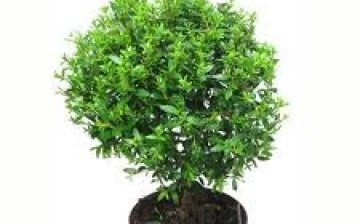Ornamental plant - Mediterranean myrtle ordinary
Common myrtle is a plant from the myrtle family. The genus myrtle unites 10 species of myrtle; breeders have also bred several varieties of this plant. Common myrtle is an evergreen woody shrub with erect stems, the stems branch well. The leaf blades are leathery and dense, they sit on short petioles, are characterized by a dark green color, they are located oppositely on the branches, the blades are oblong, pointed. In myrtle, the leaves have numerous small glands, which are found in the light. The light points of the glands are rich in aromatic substances, essential oils. When rubbed, the leaf plate smells like a distinctive, pronounced, very pleasant aroma.
Myrtle blooms with single small flowers. The flowers, depending on the variety and species, have yellow, pink, white and cream color. Myrtle flowers are characterized by a cupped shape and numerous filaments that acquire a golden color when the pollen matures. After flowering in summer, the plant forms dark blue berries that have a scent. The fruits of the myrtle bush are edible.
In indoor floriculture, the common myrtle species is Myrtus communis. New varieties were also obtained from it (small-leaved myrtle Myrtus microphylla, variegated myrtle Myrtus variegatum).
Myrtle grows well and is distinguished by branching stems. All myrtles lend themselves fairly well to pruning and crown formation. If the myrtle is not cut off, then it can even grow up to 60 centimeters in height. Pruning of the myrtle plant is carried out during transplantation, this occurs in early spring, when the shoots start to grow and the buds wake up. For a long time, myrtle has been cultivated as an ornamental plant, and in indoor culture this plant is not yet very common. Myrtle care is very simple, but it requires compliance with the light regime, regular watering. During the dormant period, a lower temperature should be maintained, since hibernation is observed after flowering.
Care
When growing myrtle, it is necessary to create bright lighting. The complete absence of sunlight for myrtle is harder to bear than direct sun. In winter, moderate lighting is acceptable, but the temperature should be lowered and moderate watering should be carried out. On hot days, myrtle needs constant hydration. Lack of moisture, high temperature, dry air, lack of lighting leads to shedding of leaves.
The optimum temperature for keeping myrtle is 20 degrees in summer, and in winter no more than 10 degrees is permissible, but myrtle can withstand a drop of up to 6 degrees. In dry air, the leaves need to be sprayed frequently and watered regularly. In winter, when pulling shoots and falling leaves, myrtle can be cut, but this can lead to a decrease in the abundance of flowering.
Transfer
Myrtle can be transplanted once every 4 years. Young seedlings should be transplanted annually in spring and before flowering. It must be remembered that it is impossible to deepen the root collar of the plant, as this can lead to diseases of myrtle, as well as to rot damage. Peat soil, turf soil and sand in equal parts are used for soil. To this composition, you can add decomposed humus, well-rotted organic compost. Periodically, it is necessary to feed the plant; for this, mineral fertilizers are used about 1 time a month. The pot is equipped with drainage.The size of the myrtle pot should be related to the size of the rhizome.
Myrtle is very fond of being in the fresh air, in this regard, the plant should be taken out into the street or balcony in the summer. But we must remember that myrtle is bad for overdrying. In hot and dry summers, prolonged exposure to the sun can be harmful. For an overdried plant, it is urgent to create cool and cold conditions of about 10 degrees. The myrtle can be placed in a homemade ice conditioner, and ice plates are placed around them, which change as the water melts. Artificially, you can create bright lighting using additional lighting with fluorescent lamps. When the myrtle begins to release young leaves, the temperature can be raised to 18 degrees, but it is necessary to maintain humidity, as well as artificially illuminate it.
The shedding of myrtle leaves may be associated with a parasite attack. In the absence of other reasons for this condition, it is necessary to carry out prophylaxis against parasites. Leaves can be affected by the scabbard, as well as thrips, which is more dangerous.
Since myrtle tolerates pruning well, you can create any shape that is used for decorative decoration.




Never in my life have I tasted the fruits of myrtle. I wonder what they taste like? Is it possible to make some kind of blanks out of them, or are they not intended for this?